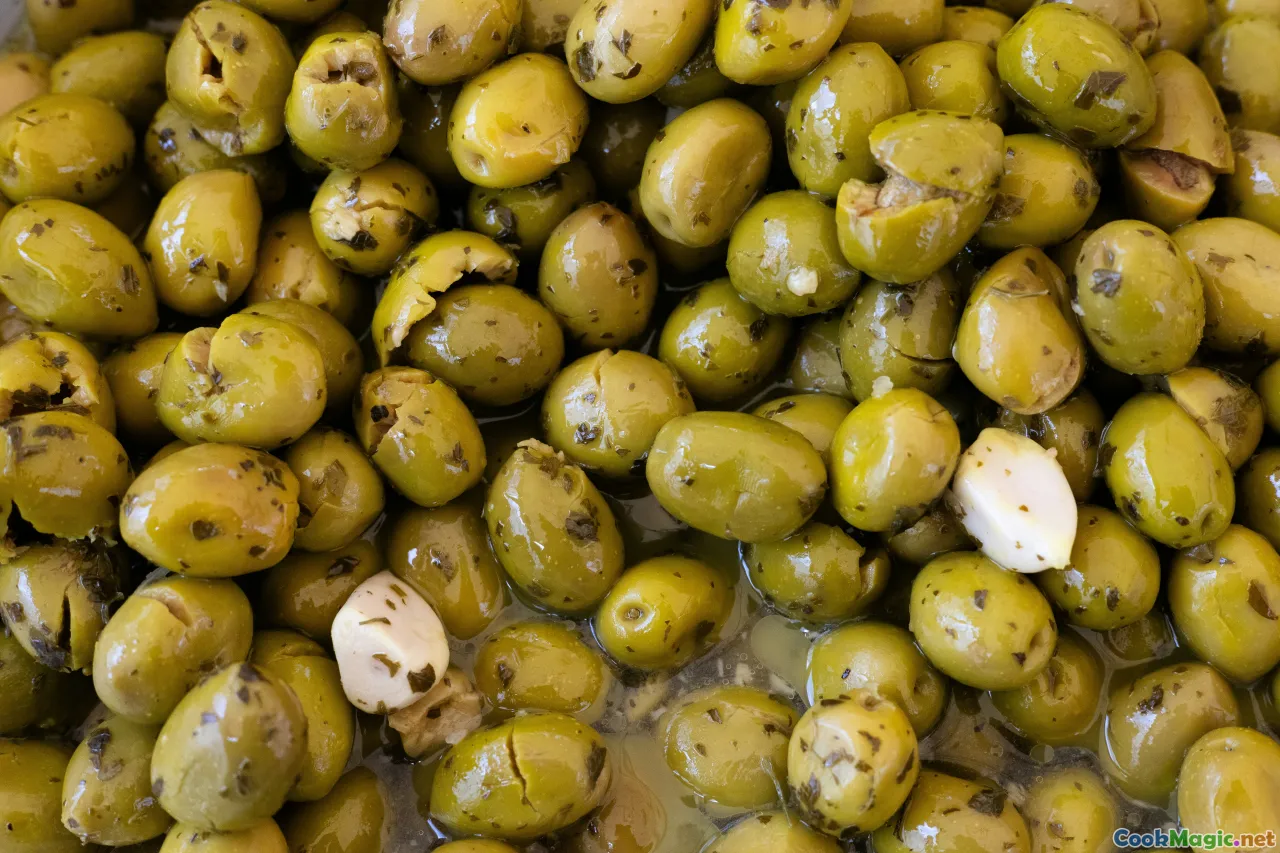
황금빛의 아스콜라나 스타일로 채운 마르키지아나 올리브
(Golden Marchigiana Stuffed Olives)
(0 리뷰)재료
-
30 pieces 큰 녹색 올리브, 가능하면 Ascolana Tenera, 씨 제거
(Choose firm, meaty olives; avoid over-brined or mushy ones)
-
150 grams 소고기 곱게 다진
(Lean cuts like round or chuck trimmed)
-
100 grams 곱게 다진 돼지고기
(Shoulder or loin works well)
-
80 grams 잘게 다진 닭고기
(Thigh meat adds moisture)
-
30 grams 프로슈토, 잘게 다진
(Adds depth and sweetness)
-
30 grams 양파, 잘게 다진 것
(Classic soffritto base)
-
20 grams 당근, 잘게 다진
(Classic soffritto base)
-
20 grams 셀러리 잘게 다진 것
(Classic soffritto base)
-
2 tbsp 엑스트라 버진 올리브 오일
(For sautéing the filling)
-
60 ml 드라이 화이트 와인
(Verdicchio or similar; for deglazing)
-
15 grams 토마토 페이스트
(Just a touch for umami and color)
-
30 grams 파르미지아노 레지아노, 곱게 간
(Adds savoriness and binding)
-
1 tsp 레몬 제스트, 곱게 간 것
(Traditional aromatic lift)
-
0.25 tsp 신선한 육두구, 간 것
(Signature seasoning in Marche fillings)
-
0.25 tsp 분쇄 흑후추
(맛에 따라)
-
1 tsp 고운 바다 소금
(Adjust to taste and brininess of olives)
-
1 large 계란
(Binder for the filling)
-
20 grams 고운 빵가루(속재료용)
(Adjust for consistency)
-
80 grams 범용 밀가루 (튀김용 코팅용)
(First coating)
-
2 large 빵가루 입히기용 달걀
(Second coating)
-
120 grams 고운 빵가루(코팅용)
(Traditional outer crust)
-
20 grams 세몰리나 또는 판코(추가 바삭함을 위해)
(Blend with breadcrumbs)
-
1 tbsp 탄산수
(Loosens egg for lighter crust)
-
750 ml 중성 튀김용 오일(땅콩/해바라기/라이트 올리브유)
(For deep-frying at 170–175°C)
-
1 pinch 꽃소금
(For finishing after frying)
-
6 pieces 레몬 조각
(서빙하기)
(Choose firm, meaty olives; avoid over-brined or mushy ones)
(Lean cuts like round or chuck trimmed)
(Shoulder or loin works well)
(Thigh meat adds moisture)
(Adds depth and sweetness)
(Classic soffritto base)
(Classic soffritto base)
(Classic soffritto base)
(For sautéing the filling)
(Verdicchio or similar; for deglazing)
(Just a touch for umami and color)
(Adds savoriness and binding)
(Traditional aromatic lift)
(Signature seasoning in Marche fillings)
(맛에 따라)
(Adjust to taste and brininess of olives)
(Binder for the filling)
(Adjust for consistency)
(First coating)
(Second coating)
(Traditional outer crust)
(Blend with breadcrumbs)
(Loosens egg for lighter crust)
(For deep-frying at 170–175°C)
(For finishing after frying)
(서빙하기)
영양 정보
- 인분: 6
- 1인분 크기: 4 stuffed olives (120g)
- Calories: 380 kcal
- Carbohydrates: 0 g
- Protein: 14 g
- Fat: 24 g
- Fiber: 3 g
- Sugar: 2 g
- Sodium: 850 mg
- Cholesterol: 110 mg
- Calcium: 140 mg
- Iron: 2.4 mg
조리법
-
1 - Prepare the soffritto:
Finely dice onion, carrot, and celery. Warm olive oil in a skillet over medium heat; sweat vegetables with a pinch of salt until translucent, 4–6 minutes.
-
2 - Brown the Meats:
Add beef, pork, chicken, and optional prosciutto to the skillet. Cook, breaking into tiny bits, until lightly browned and moisture evaporates.
-
3 - Deglaze and Season:
Stir in tomato paste; cook 1 minute. Deglaze with white wine, scraping browned bits. Reduce until nearly dry; remove from heat to cool slightly.
-
4 - Chop for texture:
Transfer meat mixture to a board and chop finely with a knife to achieve a cohesive, fine crumb without turning it into paste.
-
5 - Bind the filling:
In a bowl, combine chopped meat, Parmigiano, lemon zest, nutmeg, pepper, egg, and 20 g breadcrumbs. Mix; adjust salt. The mixture should hold together when pressed.
-
6 - Prepare the olives:
If olives are not pre-pitted, slit lengthwise in a spiral to remove pits, creating a long ribbon. Rinse quickly, then pat completely dry.
-
7 - Stuff the olives:
Pinch small nuggets of filling. Recreate each olive by rolling the olive ribbon around the filling or press into pitted olives. Aim for olive-shaped, firm balls.
-
8 - Chill for firmness:
Refrigerate stuffed olives 20 minutes to set. This prevents bursting and helps breading adhere.
-
9 - Set up breading:
Arrange three bowls: flour; beaten eggs (loosened with sparkling water if using); breadcrumbs mixed with optional semolina.
-
10 - Triple-coat:
Dredge olives in flour, shake excess. Dip in egg, then coat in breadcrumbs. For extra crunch, repeat egg and crumb steps once more.
-
11 - Heat Oil:
In a deep pot, heat oil to 170–175°C (340–350°F). Keep a stable temperature; avoid overcrowding to maintain crispness.
-
12 - Fry and finish:
Fry in small batches 2–3 minutes until deeply golden. Drain on a rack, sprinkle with flaky salt, and rest 2 minutes. Serve hot with lemon wedges.
Finely dice onion, carrot, and celery. Warm olive oil in a skillet over medium heat; sweat vegetables with a pinch of salt until translucent, 4–6 minutes.
Add beef, pork, chicken, and optional prosciutto to the skillet. Cook, breaking into tiny bits, until lightly browned and moisture evaporates.
Stir in tomato paste; cook 1 minute. Deglaze with white wine, scraping browned bits. Reduce until nearly dry; remove from heat to cool slightly.
Transfer meat mixture to a board and chop finely with a knife to achieve a cohesive, fine crumb without turning it into paste.
In a bowl, combine chopped meat, Parmigiano, lemon zest, nutmeg, pepper, egg, and 20 g breadcrumbs. Mix; adjust salt. The mixture should hold together when pressed.
If olives are not pre-pitted, slit lengthwise in a spiral to remove pits, creating a long ribbon. Rinse quickly, then pat completely dry.
Pinch small nuggets of filling. Recreate each olive by rolling the olive ribbon around the filling or press into pitted olives. Aim for olive-shaped, firm balls.
Refrigerate stuffed olives 20 minutes to set. This prevents bursting and helps breading adhere.
Arrange three bowls: flour; beaten eggs (loosened with sparkling water if using); breadcrumbs mixed with optional semolina.
Dredge olives in flour, shake excess. Dip in egg, then coat in breadcrumbs. For extra crunch, repeat egg and crumb steps once more.
In a deep pot, heat oil to 170–175°C (340–350°F). Keep a stable temperature; avoid overcrowding to maintain crispness.
Fry in small batches 2–3 minutes until deeply golden. Drain on a rack, sprinkle with flaky salt, and rest 2 minutes. Serve hot with lemon wedges.
황금빛의 아스콜라나 스타일로 채운 마르키지아나 올리브 :에 대한 자세한 정보
Marchigiana Olive All’Ascolana: A Golden Bite from the Adriatic Hills
Olive all’Ascolana is the pride of Ascoli Piceno in Italy’s Marche region—crisp, meaty, and headily scented with nutmeg and lemon. These stuffed and fried olives deliver a remarkable balance: a savory trio of meats bound with Parmigiano and bright aromas, wrapped by briny green olives and finished with a shattering crust. They’re the kind of appetizer that turns a table of strangers into fast friends.
What Makes This Version Special
- Regional fidelity: The blend of beef, pork, and chicken mirrors traditional Marchigiana practice, where multiple meats create nuance rather than heaviness.
- Aromatic clarity: Lemon zest and freshly grated nutmeg are not afterthoughts; they’re essential to lifting the richness of the filling and making the olives taste unmistakably “Ascolane.”
- Texture focus: Finely chopping the cooked meat by hand yields a delicate crumb—sturdy enough to stuff, but never pasty. A brief chill firms the shape, ensuring clean frying.
Technique Tips for Success
- Choose the right olives: Seek Ascolana Tenera if you can. If not, pick large, firm green olives with a mild brine. Too salty or soft olives can overwhelm flavor and break during frying.
- Control moisture: Reduce the wine completely and avoid a watery filling. Moisture is the enemy of adhesion and crispness.
- Hand-chop the filling: A food processor easily turns the mixture into paste. Instead, chop on a board to maintain tiny, distinct bits that hold together better.
- Triple coating pays off: Flour, then egg, then breadcrumbs. For extra armor and crunch, repeat egg and crumbs once more.
- Fry in small batches: Keep oil at 170–175°C. Overcrowding drops the temperature, leading to greasy olives.
- Rest before serving: A brief rest after frying redistributes steam, leaving the crust more brittle and less fragile.
Make-Ahead and Storage
- Day-before: Form and bread the olives, then refrigerate, uncovered, for up to 18 hours. The surface dries slightly, promoting even crisping.
- Freeze: Arrange breaded olives on a tray to freeze, then bag. Fry from frozen at 170°C for 3–4 minutes, adjusting until hot and golden.
- Reheat: Crisp leftovers in a 190°C oven for 8–10 minutes or in an air fryer at 180°C for 5–6 minutes.
Variations Across the Marche
- Cheese-forward: Swap part of the Parmigiano with Pecorino for a sharper profile.
- Citrus twist: Orange zest appears in some households; use sparingly.
- Herbaceous: A whisper of fresh marjoram or parsley is welcome, but keep it subtle.
- Vegetarian homage: Replace meat with sautéed mushrooms and walnuts, bound with ricotta and Parmigiano—non-traditional but delightful.
Serving and Pairing
Serve 4–5 olives per person as an aperitivo with lemon wedges. Pair with local Verdicchio or a chilled Rosato from the Adriatic coast. A bright, saline white cuts through the richness and echoes the olive’s briny snap.
A Bite of History and Culture
The dish is said to have originated in noble households of Ascoli Piceno, where cooks ingeniously used leftover roasts by chopping and seasoning them to stuff the region’s prized Ascolana olives. Over time, the preparation spread from aristocratic kitchens to street festivals and family gatherings. Today, Olive all’Ascolana are fixtures during festas and holidays, celebrated for their conviviality—finger food with heritage.
Troubleshooting and Pro Tips
- Olives splitting in oil: The filling may be too wet, or olives weren’t chilled. Ensure a firm set and a proper breadcrumb seal.
- Soggy crust: Oil temperature was too low or the olives sat too long before serving. Fry hot and serve promptly.
- Too salty: Soak olives briefly in fresh water, then pat dry. Adjust salt in the filling accordingly.
- Filling falling out: Pack gently but fully. Gaps between olive and filling invite oil.
Personal Notes
I love the rhythm of this recipe—the quiet chop of the meat, the quick assembly line for breading, the gentle hiss as each olive meets the oil. There is a particular satisfaction in shaping something small and perfect with your hands, then sharing it still warm, when the crust sings and the perfume of lemon and nutmeg floats upward. Whether you’re bringing a taste of the Marche to your table for the first time or honoring a family tradition, these olives carry the spirit of Italian hospitality in every bite.

















